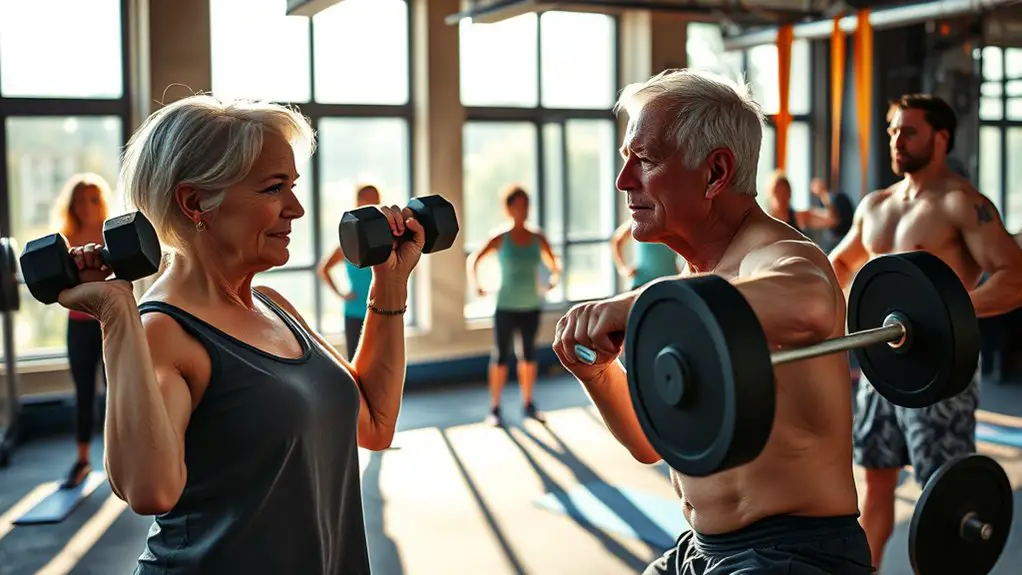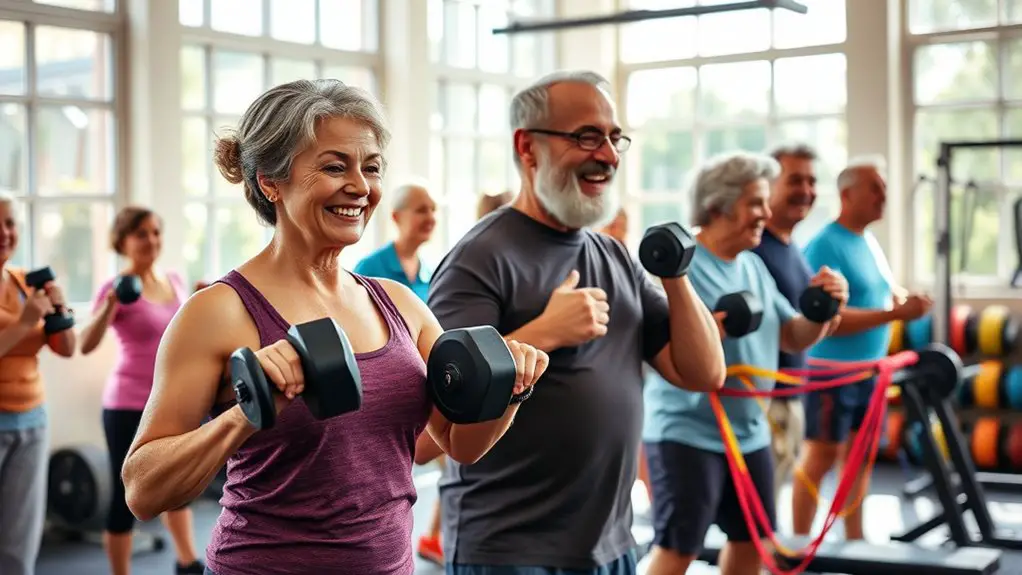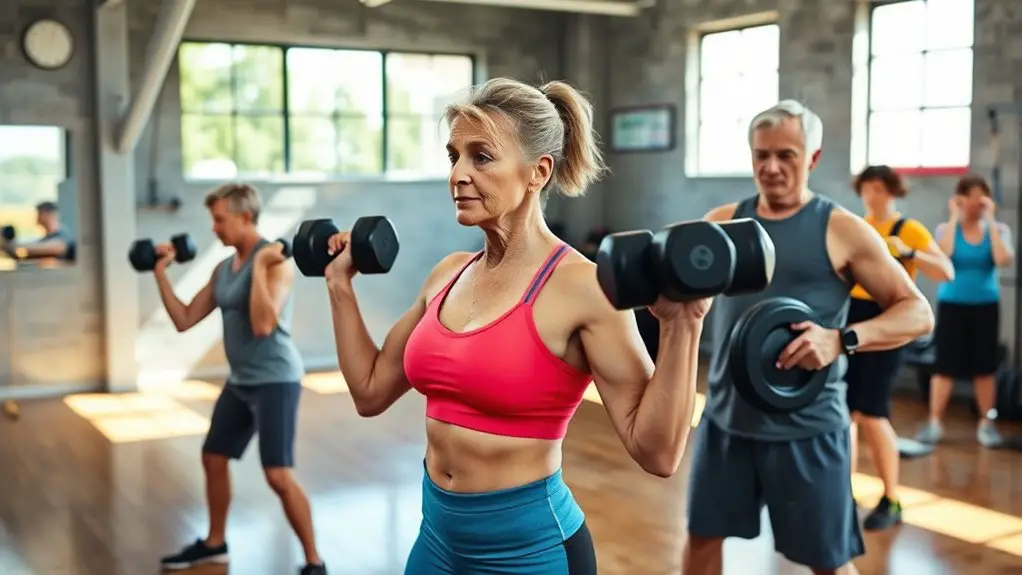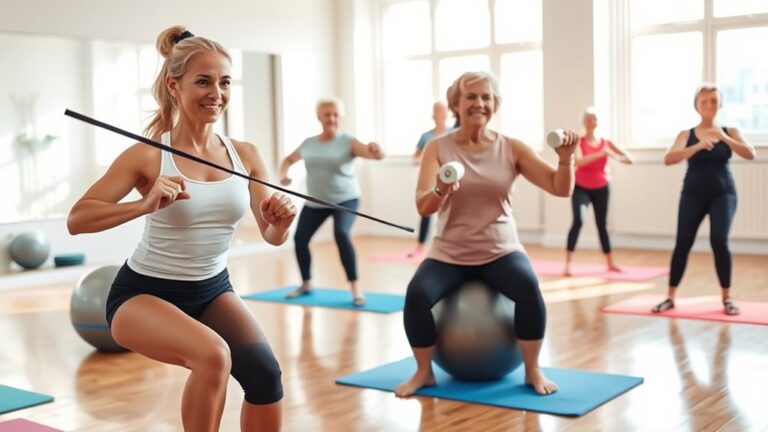The Best Strength Training Exercises for People Over 50

Strength training is essential for people over 50. It helps maintain muscle mass, boosts overall strength, and reduces injury risk. Top exercises to take into account include squats for lower body strength, push-ups for upper body development, and bent-over rows to enhance your posture. With minimal equipment like dumbbells or resistance bands, you can create effective routines at home. Consistency is key; keep your workouts varied and enjoyable. You’ll find even more tips and exercises to help you stay strong and active.
Benefits of Strength Training for Older Adults

Strength training offers numerous benefits for older adults, making it an essential part of a healthy lifestyle as you age. One key advantage is muscle preservation. As you get older, your muscle mass naturally declines, but incorporating strength training can help maintain and even build muscle, improving your overall strength and functionality. This is critical for performing daily tasks and enhancing your quality of life.
Additionally, strength training plays an important role in injury prevention. By strengthening your muscles, tendons, and ligaments, you reduce the risk of falls and injuries, which are common concerns as you age. Stronger muscles provide better support for your joints, leading to improved balance and coordination.
Engaging in regular strength training not only keeps you physically active but also boosts your confidence and mental well-being. Embracing this form of exercise can truly transform your health as you age.
Essential Equipment for Home Workouts
Creating a home workout space doesn’t have to be complicated or expensive. To get started, consider investing in a set of dumbbells. They’re versatile and allow you to perform a variety of strength exercises targeting different muscle groups. A dumbbell set with adjustable weights can be particularly beneficial, as it grows with you and your fitness level.
Another essential piece of equipment is resistance bands. These bands are compact and can easily be stored away, making them perfect for small spaces. They come in various resistance levels, allowing you to gradually increase the intensity of your workouts.
With just dumbbells and resistance bands, you can create a thorough strength training routine that suits your needs. Plus, you’ll find that these tools can help you maintain muscle mass and improve overall strength, right from the comfort of your own home. Start simple, and you’ll be amazed at what you can achieve!
Top Strength Training Exercises for Building Muscle

When it comes to building muscle, incorporating a variety of effective exercises into your routine is key. Resistance training is essential for enhancing strength and promoting muscle recovery. Here are some top exercises you should consider:
| Exercise | Target Muscles | Benefits |
|---|---|---|
| Squats | Legs, Glutes | Builds lower body strength |
| Push-ups | Chest, Triceps | Enhances upper body strength |
| Bent-over Rows | Back, Biceps | Improves posture and stability |
These exercises can be tailored to your fitness level, ensuring you stay safe and effective. Aim for two to three sets of 8-12 reps for each exercise, allowing adequate time for muscle recovery between sessions. Remember, consistency is essential, so keep challenging yourself while listening to your body. With dedication, you’ll see improvements in strength and overall well-being! Additionally, incorporating bodyweight exercises can provide a flexible training option that requires no equipment.
Tips for Enhancing Balance and Flexibility
As you age, maintaining balance and flexibility becomes essential for preventing injuries and enhancing your overall mobility. Incorporating simple balance techniques into your daily routine can make a significant difference. Try standing on one leg while holding onto a sturdy surface. Gradually increase the time you balance without support.
Flexibility routines, like gentle stretching or yoga, can also improve your range of motion. Focus on areas that tend to tighten, such as your hips, shoulders, and back. Even ten minutes a day can help you feel more limber and reduce stiffness.
Consider activities like tai chi, which blends balance and flexibility training in a fun, low-impact way. These exercises not only promote physical health but also help boost your confidence in movement. Remember, consistency is key, so find activities you enjoy to stay motivated!
Creating a Safe and Effective Workout Routine

To assure you get the most out of your strength training, it’s essential to establish a workout routine that prioritizes safety and effectiveness. Start by customizing your routine to fit your fitness level and goals. Always listen to your body and adjust exercises as needed to guarantee workout safety.
Here’s a simple framework for creating your routine:
| Exercise Type | Frequency |
|---|---|
| Upper Body Strength | 2 times/week |
| Lower Body Strength | 2 times/week |
| Core Stability | 1-2 times/week |
| Flexibility Training | Daily |
| Cardio Activities | 3 times/week |
Incorporating variety keeps things interesting and helps you stay motivated. Additionally, consider consulting a fitness professional for personalized advice. Remember, routine customization is key to enjoying your strength training journey while minimizing injury risk.
Frequently Asked Questions
How Often Should Older Adults Strength Train Each Week?
Think of your muscles as a garden; they need regular care to flourish. For older adults, frequency recommendations suggest strength training at least two to three times a week. You can mix in training variations like resistance bands, free weights, or bodyweight exercises to keep things fresh and engaging. This approach not only strengthens your muscles but also enhances balance and flexibility, making it easier to enjoy life’s activities with confidence and ease.
Can Strength Training Help With Arthritis Pain?
Yes, strength training can definitely help with arthritis pain. It’s been shown to provide arthritis relief by strengthening the muscles around your joints, which enhances joint mobility and reduces discomfort. You don’t need to lift heavy weights; even light resistance exercises can be beneficial. By incorporating strength training into your routine, you’ll likely notice improved flexibility and less pain, making daily activities easier and more enjoyable. Just be sure to start slowly and listen to your body!
What Should I Eat Before and After Workouts?
So, you think snacking before and after workouts is just a way to justify your love for food? Well, think again! Pre workout snacks like bananas or yogurt fuel your energy, while post workout meals, rich in protein and healthy carbs, help your muscles recover. It’s almost as if the universe rewards your hard work with delicious food! So, don’t skip out—nourish your body to keep those gains coming strong!
Are There Specific Warm-Up Exercises for Seniors?
Absolutely, there are specific warm-up exercises tailored for seniors. You should focus on dynamic stretches and mobility exercises to prepare your body for activity. Try arm circles, leg swings, and gentle torso twists to increase flexibility and blood flow. These movements help loosen up your joints and muscles, reducing the risk of injury. Always listen to your body, and adjust the intensity as needed to guarantee a safe and effective warm-up routine.
How Can I Track My Progress Effectively?
To track your progress effectively, start by utilizing progress measurements like weight lifted, repetitions, and sets. Consider fitness journaling to record these details after each workout. This helps you see trends over time, making adjustments easier. You could also take photos or measurements to visualize changes in your physique. Regularly reviewing your entries can motivate you and keep you accountable, ensuring you stay on track toward your fitness goals.





